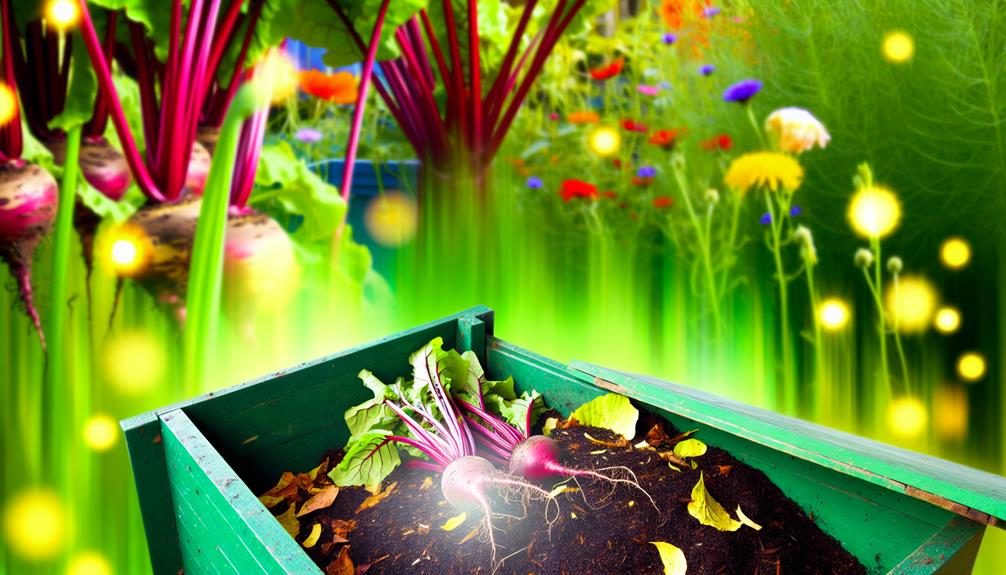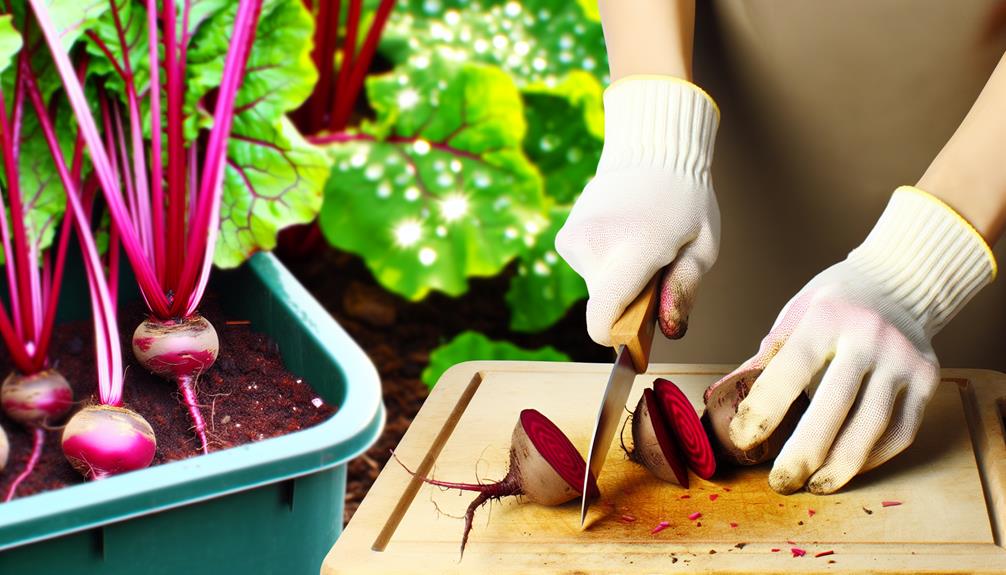

You can definitely compost beet root, and it’s a fantastic way to enrich your garden soil! Beetroot adds essential nutrients like potassium, magnesium, and iron, helping your plants thrive. Chop them into smaller pieces to guarantee speedy decomposition, and balance with other green and brown materials in your compost.
This not only improves water retention in the soil but also supports beneficial microorganisms. Regularly turning your compost guarantees everything breaks down evenly. By composting beetroot, you’re reducing waste and promoting a sustainable lifestyle. Want to know how to make your soil even healthier? Keep exploring these tips!
By composting beet root, you can enrich your soil with essential nutrients and improve its overall health. When you add composted beet root to your garden, you’re creating a vibrant community for beneficial microorganisms. These tiny helpers break down organic matter, releasing nutrients that plants need to thrive.
You’ll notice better water retention in your soil, reducing the need for frequent watering. Plus, composting beet root helps reduce waste, promoting a more sustainable lifestyle. Imagine joining a community of gardeners who are passionate about nurturing the earth!
Also Read: Can You Compost Cantaloupe?
Understanding the nutrient composition of beet root helps you make the most of its benefits when composting. Beet roots are rich in essential nutrients like potassium, magnesium, and iron. When you add them to your compost, these minerals enhance the soil quality, promoting healthier plant growth.
They also contain nitrogen, which is crucial for creating a balanced compost pile. This nutrient helps accelerate the decomposition process, making your compost more effective. Additionally, beet roots have natural sugars that feed beneficial microbes, fostering a thriving compost ecosystem.
Before adding beet roots to your compost, make sure to chop them into smaller pieces to speed up the decomposition process. Smaller pieces break down faster, enriching your compost more quickly. Use a sharp knife or a garden shredder for this task, taking care to remove any soil clumps. Clean beet roots promote a healthier compost environment, reducing the risk of unwanted pests.

Next, consider peeling the beets if they’ve any tough outer skin. This additional step helps even more with faster breakdown. Don’t forget to include beet greens, which are also compostable!
Balancing greens and browns in your compost is essential for achieving the right carbon-nitrogen ratio. This ratio helps your compost break down efficiently. Greens, like beet roots, provide nitrogen, while browns, such as dried leaves or cardboard, add carbon.
Make sure to manage moisture levels by keeping your compost pile damp but not soggy. Regularly mix your organic materials to guarantee even decomposition.
To achieve peak composting with beet root, you need to maintain the right carbon-nitrogen ratio by balancing greens and browns. Greens, like beet root and vegetable scraps, are rich in nitrogen and provide essential proteins. Browns, such as dried leaves or cardboard, offer carbon, which fuels the decomposers.
Aim for a mix that’s roughly 30 parts carbon to 1 part nitrogen. This balance guarantees efficient decomposition and reduces odors. Layer your compost with alternating greens and browns, making sure each layer is thin and well-mixed. This way, your compost pile remains alive and active, fostering a sense of community with nature.
Maintaining the right moisture levels in your compost pile is just as important as balancing greens and browns. Your compost should be as damp as a wrung-out sponge. Too dry, and decomposition slows; too wet, and it can get stinky and slimy. Greens like beet root add moisture, while browns like dry leaves absorb it. Balance these to create a thriving compost pile.
Test the moisture by squeezing a handful; it should feel moist but not drip. If it’s too wet, add more browns and turn the pile to incorporate air. If too dry, sprinkle some water and mix in more greens.
Always make sure to mix a variety of greens and browns to create a balanced and nutrient-rich compost pile. Greens, like beet roots, provide nitrogen, while browns, such as dry leaves and cardboard, offer carbon. This importance is essential for a healthy compost pile that breaks down efficiently.
Remember, greens include kitchen scraps, coffee grounds, and fresh grass clippings. Browns encompass materials like straw, wood chips, and paper. By layering these materials, you guarantee that microorganisms have the right environment to thrive. They’ll break down the organic matter faster, resulting in rich, dark compost.
Don’t forget to turn your pile regularly to aerate it, helping to speed up the decomposition process and keep everything well-mixed.
Also Read: Can You Compost Wool?
One of the most common pitfalls in composting beet root is adding too much at once, which can disrupt the balance of your compost pile.
When you overload your compost with beet root, it can lead to an excess of moisture and a lack of airflow. This can cause your compost to become slimy and smelly, making it less effective.
To avoid this, mix beet root with a variety of other compostable materials, like dry leaves or shredded paper, to maintain the right balance of greens and browns.
Also, chop beet root into smaller pieces to help it break down more evenly. By being mindful of these practices, you’ll create a healthier, more efficient compost pile that benefits your garden.
To speed up the decomposition of beet root in your compost pile, consider adding nitrogen-rich materials like grass clippings or kitchen scraps. This addition helps to balance the carbon-to-nitrogen ratio, accelerating the breakdown process. Turn your compost regularly to aerate it, ensuring the microbes get enough oxygen to work efficiently.
Here’s a quick reference table to help you manage your compost:
| Material | Carbon-to-Nitrogen Ratio | Decomposition Speed |
|---|---|---|
| Grass Clippings | High Nitrogen | Fast |
| Kitchen Scraps | High Nitrogen | Fast |
| Shredded Paper | High Carbon | Slow |
| Beet Root | Balanced | Medium |
| Coffee Grounds | High Nitrogen | Fast |
In addition to composting, you can use beet root greens as a nutritious addition to your meals. These vibrant, leafy greens are packed with vitamins A, C, and K, along with essential minerals like potassium and magnesium. Adding beet greens to your diet can boost your overall health and contribute to a sense of well-being.

You can sauté them with garlic, olive oil, and a pinch of salt for a quick, tasty side dish. Alternatively, toss them into soups, smoothies, or salads to add a burst of flavor and nutrients.
Also Read: Can You Compost Carrot Peel?
Incorporating beet root into your vermicomposting setup can greatly boost the nutrient content of your compost. Beet roots are rich in essential nutrients that worms love, helping them thrive and break down organic matter more efficiently.
When you add beet root to your vermicomposting system, you introduce a powerhouse of nutrients that can greatly enhance the quality of your compost. Beet roots are rich in essential minerals like potassium, magnesium, and iron, which can notably boost soil health.
When these nutrients break down, they create a fertile environment for plant growth, encouraging stronger and more vibrant vegetation in your garden. Additionally, beet roots contain beneficial organic matter that improves soil structure, aiding in better water retention and aeration.
Worms absolutely love beet root, making it a great addition to your vermicomposting setup. Adding beet root boosts the nutrient content in your worm bin, providing worms with a rich food source.
The high sugar content in beets makes them particularly appealing to worms, which in turn accelerates the breakdown process. When you chop beet root into smaller pieces, it becomes easier for worms to consume and decompose, speeding up composting.
Just be mindful not to overload your bin with too much beet root, as it can create an ideal environment. Balance it with other vegetable scraps and bedding materials for best results.
Also Read: Can You Compost Cardboard Tubes?
Using composted beet root can greatly enhance your soil’s nutrient profile, leading to healthier plants and more robust growth. When you add composted beet root to your garden, you’re introducing essential nutrients like potassium, magnesium, and iron.
These nutrients help your plants develop stronger roots, vibrant leaves, and more abundant fruits. Additionally, composted beet root improves soil texture, making it easier for roots to penetrate and access water.
| Nutrient | Benefit | Source |
|---|---|---|
| Potassium | Strengthens root growth | Beet root |
| Magnesium | Boosts chlorophyll | Composted beet |
| Iron | Enhances leaf color | Beet root |
| Nitrogen | Promotes foliage growth | Organic matter |
| Phosphorus | Supports flower/fruit | Decomposed beet |
Composting beet roots is a fantastic way to enrich your garden soil, giving it a boost of essential nutrients. By balancing greens and browns, preparing the roots properly, and avoiding common pitfalls, you’ll create a rich, fertile compost.
Don’t forget, beet greens are compostable too and vermicomposting is an excellent method!
Start composting beet roots today, and watch your garden thrive with healthier plants and improved soil health. You’re making a positive impact on the environment!
